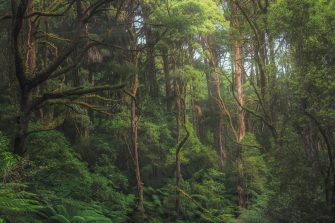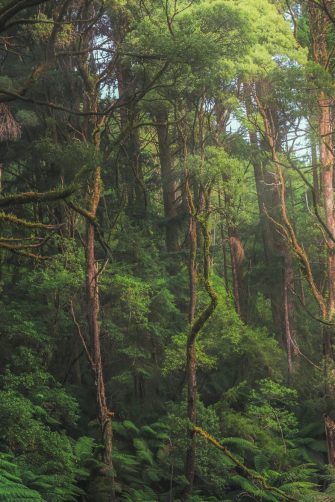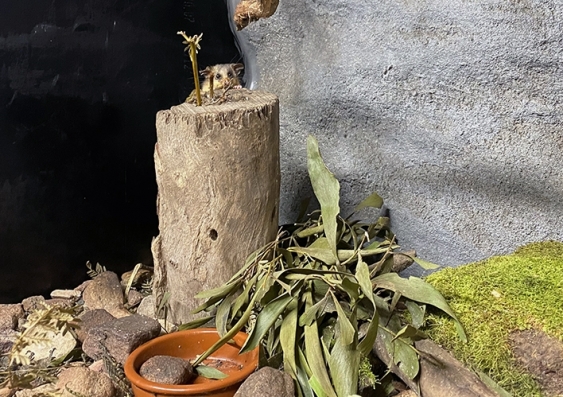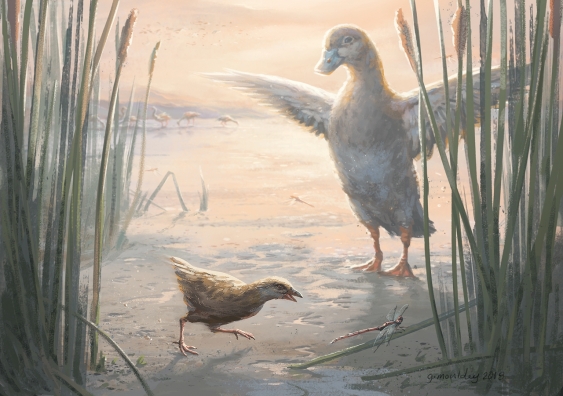The distant past could provide clues to a species' immediate future.
When endangered species are seen struggling to survive it’s easy to assume they can be saved by giving them more of what they have now – more of the same habitat, more of the same diet in more or less the same climate.
But what if the animals we see today hanging in there by tooth and nail are actually at the absolute edge of what’s tolerable to them? What if they could flourish in very different environments, eat different foods and live in different climatic conditions?
This is the idea behind some novel rewilding projects that have been driven by scientists, ecologists and conservationists as part of the palaeoconservation movement.
Professor Mike Archer at UNSW Sydney’s School of Biological, Earth and Environmental Sciences says there are enough important clues in the distant past – contained in the fossil record – to improve conservation strategies for the future.
“Many animals and plants have a wider adaptive resilience than their current situations might suggest,” he says.
A case in point is Burramys parvus, aka the Mountain Pygmy-possum, a critically endangered mammal in the Snowy Mountains region in eastern Australia. Prof. Archer was the first to make the link between this native species of eastern Australia’s Snowy Mountain alpine region, and a direct ancestor discovered in the incredibly rich fossil deposits in the Riversleigh World Heritage Area, Queensland.
“Almost identical ancestors were thriving in cool, temperate lowland rainforests 25 million years ago. We believe they moved into the alpine area during a warm, wet period during the Pleistocene, but when the climate changed, they became stranded there, just able to survive by hibernating in winter and avoiding the temperature extremes that characterise the alpine zone.
“And now climate change is threatening them once again, with possibly only 2000 left alive. But using our knowledge of the fossil record, we have proposed that they could be reintroduced into the environments where they were once abundant and thrived for millions of years.”
Together with Mountain Pygmy-possum experts Dr Hayley Bates and Linda Broome, and with the support of government and environmental NGOs including Australian Geographic, Australian Ecosystems Foundation and even the Prague Zoo in the Czech Republic, Prof. Archer set about establishing a breeding facility in a lowland rainforest environment.
Prof. Archer enlisted the help of Trevor Evans at Secret Creek Sanctuary in Lithgow to raise funds for the construction a new, purpose-built breeding facility. The idea was that it would test their ability to thrive in lowland rainforests. The team has now introduced a small number of Mountain Pygmy-possums to the facilities to begin breeding at Secret Creek.
“This project is already working in just the way we predicted based on our understanding about the fossil record,” Prof. Archer says. “The animals are now thriving in the new lowland environmental conditions and have even begun to mate and produce cute little youngsters.”
The group is hoping to have a trial release of the first lot of Mountain Pygmy-possums into the wild within the next couple of years. But this isn’t the first, and certainly not the last time that palaeoconservation has informed the rescue of species at the brink.
Below are four more cases where translocations informed by palaeoconservation have already helped or could help to save some struggling species that are almost out of time.
1. Western Australian Swamp Tortoise (Pseudemydura umbrina)
Once thought to be extinct for 100 years prior to its rediscovery in 1953, this small reptile was, just a few decades ago, tottering at the edge of extinction. Scientists estimated its numbers were as low as 50 in the wild.
Last year 200 of them that had been bred in captivity were released into the wild by Western Swamp Tortoise Recovery Team led by the WA state government’s department of Biodiversity, Conservation and Attractions. But rather than release them into their two known habitats, these diminutive animals – weighing no more than half a kilogram – were translocated 80km north of Perth to Scott National Park and Moore River Nature Reserve.
But with most of coastal Western Australia predicted to become drier as climate change bites, reaching even further back in time for help could be the key to the species' future. The fossil record from the Riversleigh World Heritage Area has revealed that a closely related, if not the same species as the modern day Pseudemydura umbrina, once roamed very different areas of Australia.
“The tortoise is critically endangered in part because the swamps where it occurs at the moment are gradually drying up,” says Prof. Archer.
“But perhaps there’s a different palaeoconservation informed strategy that could save this turtle. We have found specimens of the same genus and quite possibly the same species in a 15-million-year-old deposit in the Riversleigh World Heritage Area in Queensland. This wasn’t a dry desert swamp area at that time; these fossils were found in what would have been a freshwater pond in a cool, temperate lowland rainforest. Hence future efforts to conserve this turtle could perhaps seek out similar ponds in the rainforests of eastern Australia, ideally where there are no other turtles with which it might compete.”
2. Takahē bird, New Zealand (Porphyrio hochstetteri)
This medium-sized, flightless swamphen belonging to the rail family of birds was thought to be extinct for a century until 1948 when it was rediscovered in the Murchison Mountains on the South Island of New Zealand.
At the time of its rediscovery, the Takahē was found in alpine grasslands, having declined after its swampland habitat was turned into farmland by European settlers in the 19th and 20th centuries.
After fears that the birds would soon become extinct without intervention, the New Zealand government launched a breeding and translocation program in the 1980s which continues to this day. Populations of Takahē have now been established on five small islands of New Zealand, with the goal of getting the birds to develop a self-sustaining population of more than 500. And it appears to be working – as of 2019, their numbers had reached 418.
“The whole idea about moving Takahē from their alpine area, where they were declining, was based in the first place on one of the people involved pointing out that there were bones of Takahē in Pleistocene fossil deposits in the lowlands of New Zealand,” says Prof. Archer.
“It’s a success story because they went ahead with the trial translocation even though there were others who were saying at the time that it would never work because the foods and other habitat features wouldn’t be the same. In my view, these criticisms, which were similar to those we heard when we first suggested the Burramys Project, were an inappropriate use of the precautionary principle, which, if used as a reason for doing nothing, would probably have led to the rapid extinction of this bird.”
3. Giant Panda (Ailuropoda melanoleuca)
The giant panda lives today in mountainous areas of central China, primarily in the Sichuan, Shaanxi and Gansu provinces. It is considered a critically endangered species, numbering around 1800 individuals according to a survey carried out in 2021. However, in the late 1990s their numbers were as low as 1100. A conservation program that focused on establishing more montane bamboo forests and corridors that allow pandas to move between forests has been attributed to the increase in their numbers, as well as a breeding program.
However, when the historic distribution of the Giant Panda is examined, it is clear that it used to occupy areas of lowland China as well as the mountainous regions. Dipping further back in time into the fossil record of this species, their lowland distribution area was even vaster than their historic range.
For this reason, Prof. Archer thinks it would make sense to widen efforts to conserve them in lowland arears.
“It would probably make sense to use palaeoconservation understanding to translocate a population of this endangered species into the less stressful, climatically more pleasant areas in the lowlands where bamboo forests could be re-established. These lowland areas would be much closer to the centre of their original distribution, rather than just trying to conserve them in the more challenging, mountainous edges of their original range.”
4. The Southern Corroboree Frog (Pseudophryne corroboree)
The critically endangered Southern Corroboree Frog’s inclusion in this list is somewhat unusual because its ancestors have not yet been found in Australia’s fossil record. However, like the Mountain Pygmy-possum, today it is restricted to and declining in the same alpine zone in Australia. Like the possum, this brightly-coloured iconic frog even hibernates to survive the cold alpine winter.
Prof. Archer suggests that it is possible that its ancestors were in those same lowland rainforests that hosted the ancestors of the Mountain Pygmy-possum. With its numbers in the wild now down to perhaps 30 individuals, he thinks that a similar conservation translocation experiment might help to save this frog from extinction in the wild.
“Perhaps we could think about the Mountain Pygmy-possum’s fossil record as a proxy for the missing fossil records of other similarly threatened alpine animals and plants.
“Because we see it in the same alpine area as Burramys parvus, it is at least probable that these frogs followed a similar prehistoric path along with this possum and other species up into the alpine zone where they are now stranded.
“Given that climate change is now driving it towards extinction in the alpine zone, it would seem sensible to at least consider the conservation value of translocating a population out of the alpine zone and down into the same lowland wet forest environments that kept species of Burramys comfortable for at least the last 25 million years.”







